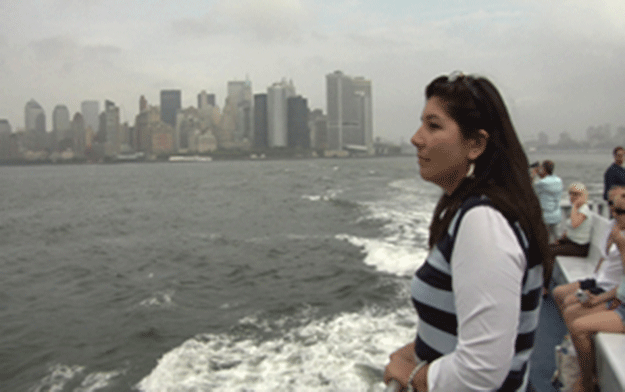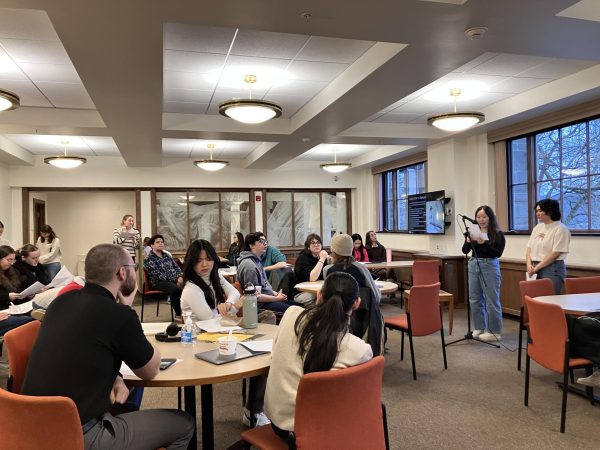Friday Night Film Series Features To Brooklyn and Back: A Mohawk Journey
Tarbell on a New York City ferry, overlooking the Manhattan skyline that her ancestors helped build.
One woman’s journey to understand her past cumulated almost 10 years ago in a 2008 documentary that provided insight into the lives of the Kahnawake Mohawks of Quebec, Canada and their connection to iron working in Brooklyn. This film was featured in the latest installment of Colgate’s regular Friday Night Film Series. Filmmaker Reaghan Tarbell attended the screening of her award-winning film, To Brooklyn and Back: A Mohawk Journey, in Little Hall’s Golden Auditorium on Friday, November 10, which brought together members of the Colgate community with local Oneida tribe members also in attendance.
Director of the Native American Studies Program Carol Ann Lorenz introduced both the film and filmmaker, after acknowledging “with great respect” the Oneida Indian Nation. Colgate is built on the ancestral land of the Oneidas and many of members of the Oneida Indian Nation came to the viewing. The Film and Media Studies Program also collaborated to screen the film. The film took four years to complete and eventually won Best Feature Documentary at the 2008 Winnipeg Aboriginal Film Festival.
Tarbell set out to create the documentary because she wanted to understand where her ancestral origins and delve into the Mohawk connection to Brooklyn. The Kahnawake Mohawks were known for their skilled ironwork, and the men began to travel to New York City in search of work in the industrial age. As they migrated with their wives and families, a community that later became known as “Little Caughnawaga” formed in the North Gowanus area of Brooklyn. At times, as many as 700 Mohawks lived in this area of Brooklyn, making it a home away from home for the growing number of Mohawks present. Tarbell completed and produced the film in 2008, and it was screened on the Public Broadcasting Service (PBS) one year later.
“I think if you’re destined to tell a story it will find you somehow. Telling the story about my family and my community was at the same time the most challenging and rewarding time of my life,” Lorenz said, quoting a sentiment Tarbell has previously shared regarding her documentary.
While the male ironworkers in the community, who played a large role in making the Manhattan skyline, could easily have been the focus of the documentary, Tarbell instead told the story through interviews with the women of the tribe. The Mohawk ironworkers helped construct the Empire State Building, the United Nations building, the Rockefeller Center and the Arizona Bridge during the 1920s construction boom, but the wives and mothers who move the entirety of their lives to New York to raise their families while seeking job opportunities also had an impact.
“Growing up, my grandfathers were both ironworkers. I always heard about New York and iron working from the women’s perspective – my grandmother, because she lived there, and my aunts, because they were both married to ironworkers. That made a real impact on me. I felt that the iron working story … is an important one, but I wanted to give a different perspective as we are a matriarchal society. I wanted the women of that time to be heard, for their voices to be heard,” Tarbell said.
Tarbell spent a summer in Caughnawaga interviewing many of her family members and influential women in the community. Some of the interviewees were working on constructing a memorial for the 100 year anniversary of the Quebec Bridge Disaster, a bridge collapse that took the lives of 33 Mohawk ironworkers. The story was told by weaving together the voices of these women with a history of Tarbell’s tribe and abundant archival documents. Some of these images were acquired from The National Geographic, who featured Tarbell’s family at one point, and the Rockefeller Center.
Tarbell remains grateful her film is still traveling ten years after its production but believes the content continues to be important. Currently, as the Executive Director of the The Kanien’kehaka Raotitiohkwa Language and Cultural Center in Caughnawaga, she is learning her native language and working to preserve the Mohawk culture.
“I feel like that’s another journey for myself in learning who I am. My experience growing up was not really having my language and not really having my culture so I’m still learning,” she said.
Tarbell left Brooklyn to return Caughnawaga. She is now raising her children there and attempting to raise funding for a new project that plans to explore the connection between Mohawk men and the military.
Contact Lauren Hutton at [email protected].
Lauren Hutton is a senior from Pembroke Pines, Florida double concentrating in Women’s Studies and English with a creative writing emphasis. She has...







